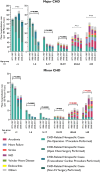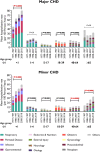Temporal Trend in Hospitalization Among Patients With Congenital Heart Disease: A Danish Nationwide Study
- PMID: 39258557
- PMCID: PMC11935602
- DOI: 10.1161/JAHA.124.035115
Temporal Trend in Hospitalization Among Patients With Congenital Heart Disease: A Danish Nationwide Study
Abstract
Background: The congenital heart disease (CHD) population is growing and aging. We aim to examine the impact by describing the temporal trend and causes of lifetime hospitalization burden among the CHD population.
Methods and results: From the Danish National Patient Registry, 23 141 patients with CHD and their hospitalizations from 1977 to 2018 were identified, excluding patients with extracardiac malformation. Patients with CHD were categorized into major CHD and minor CHD, and each patient was matched with 10 controls by sex and year of birth. The rate of all-cause hospitalization increased over time from 28.3 to 36.4 hospitalizations per 100 person-years (PY) with rate difference (RD) per decade of 2.5 (95% CI, 2.0-3.1) hospitalizations per 100 PY for the patients with CHD, compared with the increase from 10.8 to 17.0 per 100 PY (RD per decade, 2.0 [95% CI, 1.8-2.2] per 100 PY) for the control group (RD for CHD versus control, P=0.08). The all-cause hospitalization rate remained constant for the major CHDs (RD per decade, -0.2 [95% CI, -1.2 to 0.9] per 100 PY) but increased for the minor CHDs (RD per decade, 5.2 [95% CI, 4.3-6.0] per 100 PY). For all patients with CHD, the cardiovascular hospitalization rate remained constant over time (RD per decade, 0.2 [95% CI, -0.3 to 0.6] per 100 PY) whereas the noncardiovascular hospitalization rate increased (RD per decade, 2.1 [95% CI, 1.6-2.7] per 100 PY). The length of all-cause hospital stays for all patients with CHD decreased from 2.7 (95% CI, 2.6-2.8) days per PY in 1977 to 1987 to 1.6 (95% CI, 1.6-1.7) days per PY in 2008 to 2018.
Conclusions: Compared with previous decades, patients with CHD have an increasing hospitalization rate, similar to the general population, but a decreasing length of hospital stay. The increase in hospitalization rate was driven by noncardiovascular hospitalizations, with the patients with minor CHD being the key contributor to the increasing rate.
Keywords: all‐cause hospitalization rate; cardiovascular hospitalization; congenital heart disease; length of hospital stay; noncardiovascular hospitalization; temporal trend.
Figures




Similar articles
-
Congenital Heart Disease Hospitalizations in Canada: A 10-Year Experience.Can J Cardiol. 2016 Feb;32(2):197-203. doi: 10.1016/j.cjca.2015.05.022. Epub 2015 Jun 4. Can J Cardiol. 2016. PMID: 26341305
-
Arrhythmias in congenital heart disease: A nationwide cohort study.Am Heart J. 2024 Dec;278:139-149. doi: 10.1016/j.ahj.2024.08.020. Epub 2024 Sep 2. Am Heart J. 2024. PMID: 39233212
-
Pediatric inpatient hospital resource use for congenital heart defects.Birth Defects Res A Clin Mol Teratol. 2014 Dec;100(12):934-43. doi: 10.1002/bdra.23262. Epub 2014 Jun 27. Birth Defects Res A Clin Mol Teratol. 2014. PMID: 24975483 Free PMC article.
-
Length of hospital stay after delivery among Danish women with congenital heart disease: a register-based cohort study.BMC Pregnancy Childbirth. 2021 Dec 7;21(1):812. doi: 10.1186/s12884-021-04286-3. BMC Pregnancy Childbirth. 2021. PMID: 34876061 Free PMC article.
-
Time Trends in Simple Congenital Heart Disease Over 39 Years: A Danish Nationwide Study.J Am Heart Assoc. 2021 Jul 20;10(14):e020375. doi: 10.1161/JAHA.120.020375. Epub 2021 Jul 3. J Am Heart Assoc. 2021. PMID: 34219468 Free PMC article.
Cited by
-
Epidemiological characteristics and trends based on a joinpoint regression model of preterm birth with congenital heart disease in Changsha City, China, from 2011 to 2023.Transl Pediatr. 2025 Mar 31;14(3):382-390. doi: 10.21037/tp-24-411. Epub 2025 Mar 26. Transl Pediatr. 2025. PMID: 40225084 Free PMC article.
References
-
- Erikssen G, LiestØl K, Seem E, Birkeland S, Saatvedt KJ, Hoel TN, Døhlen G, Skulstad H, Svennevig JL, Thaulow E, et al. Achievements in congenital heart defect surgery: a prospective, 40‐year study of 7038 patients. Circulation. 2015;131:337–346. doi: 10.1161/CIRCULATIONAHA.114.012033 - DOI - PubMed
MeSH terms
LinkOut - more resources
Full Text Sources
Medical
Miscellaneous

